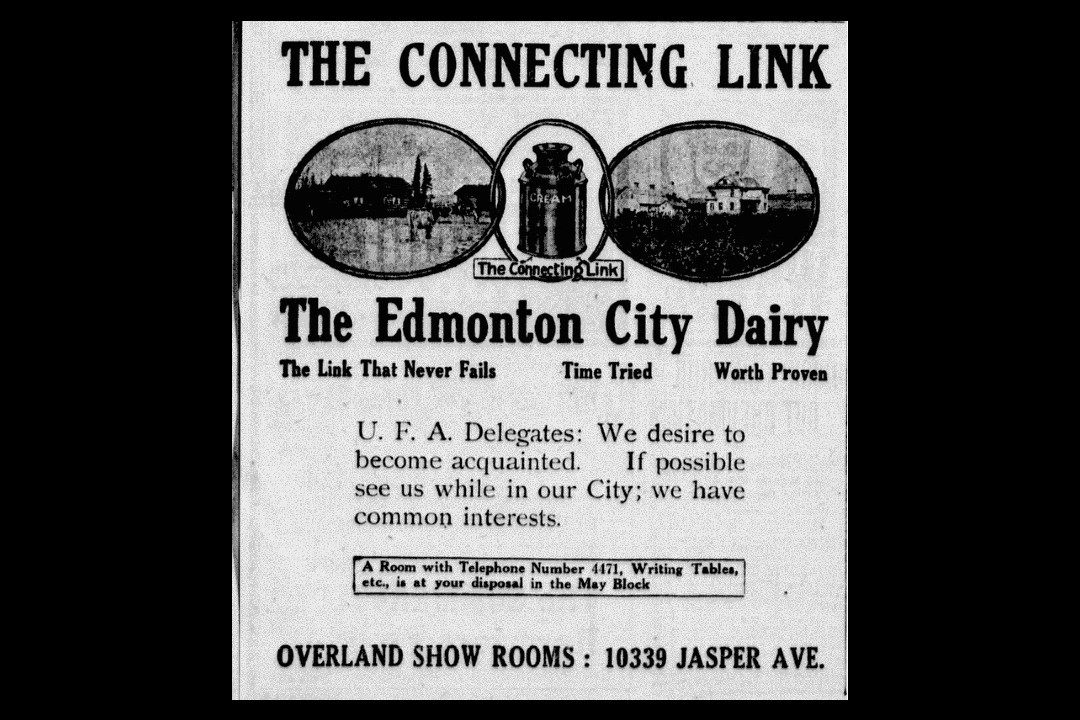On this day in 1919, one of Edmonton's largest dairies was courting delegates from the United Farmers of Alberta.
Cattle and ranching have been a part of Alberta's identity for longer than it has been a province. Early advertisements created to entice European settlers to the area focused on farming and ranching as lucrative opportunities for anyone willing to move out west. An 1889 booklet made a special case for what became Alberta as the ideal location for dairy farming. It promised natural grazing lands, "sparkling springs of cold mountain water" and the absence of "highly flavoured noxious weeds" that might affect milk production if cows ate them.
These pledges of land without tasty weeds seemed to work as many settlers established dairy farms, including in the Edmonton area. The first commercial dairy near the city was likely the West End Dairy, established in 1899. It was located in what was considered west Edmonton at the time — around 110 Street and 99 Avenue. The dairy was soon delivering milk, butter, and other dairy products by horse-drawn wagon to the homes of people in the growing settlement.
The early part of the 1900s was a boom time for Edmonton, but it wasn't just the population that was on the rise. Prosperity also increased, and as the city grew larger and wealthier, demand for milk, cheese, and butter continued to rise. With this came more dairies to fulfill the need. The Edmonton City Dairy was one of them. It was founded in 1906 and soon grew to be one of the city's largest, alongside others like the Woodland Dairy and the Jasper Dairy.
By the 1910s, dairy production had become a vital part of Edmonton's economy. Production served local residents but was also shipped and sold in eastern Canada and British Columbia. By 1916, the Edmonton City Dairy had grown to be the largest butter factory in the country, churning up more than 2.5 million pounds of butter annually.
Dairy was still big business in Edmonton in the 1920s, and it made its mark on the city's skyline. In 1928, Edmonton City Dairy commissioned a 27-foot-tall steel milk bottle for the roof of its new building near Jasper Avenue and 109 Street. The eight-ton landmark was made in New York and shipped to the city. This behemoth bottle wasn't all show, however: it also served as the condenser for the building's refrigeration system.
The bottle outlasted the dairy itself, as it remained on the building after ECD was bought and turned into the Silverwood Dairy.
The 1930s saw the number of milk producers peak in the province, topping out at around 36. Then producers started to decline. New technology and disappearing farmland pushed smaller dairies out. They sold their farms to a shrinking number of mega-producers.
In the latter half of the century, dairy became a less important part of Edmonton's economy. Faster shipping, better refrigeration, and other factors saw more competitors arrive from outside the city. Eventually, Silverwood shut down. Their building was demolished in 1977. That massive milk bottle survived, though, and was moved to Northlands Park.
Edmonton's dairy industry might not be the powerhouse it used to be, but it wasn't forgotten. Home delivery of milk bottles lasted a surprisingly long time — Edmonton's last door-to-door milkman retired in 2012. And there is still a robust community of collectors who seek out old milk bottles, each stamped with the logos and names of the now-defunct dairies.
Milk production is still big in Alberta, with about 500 dairies across the province. And like everything else, technology continues to change the industry. Just last year, an Edmonton start-up announced a project to develop artificial intelligence to identify injured or ill milk cows using photos or videos.
This clipping was found on Vintage Edmonton, a daily look at Edmonton's history from armchair archivist @revRecluse of @VintageEdmonton.

